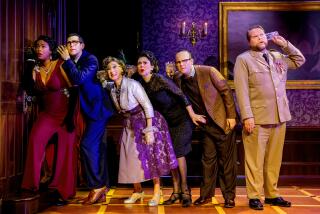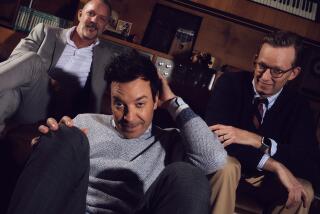Making sure the host has a cue
- Share via
Courtney Philbrook Chapman
Dialogue coordinator, a.k.a. the cue card person, on ABC’s “Jimmy Kimmel Live”
Credits: “The Young and the Restless,” “Saturday Night Live,” “The Man Show,” “Late Show With David Letterman” and “Late Night With Conan O’Brien.”
The juggling act: “Basically, I am responsible for the scripts from beginning to end, so starting out with Jimmy’s monologue and then the intros and outros. It’s kind of a unique process. Jimmy really writes every word. He wrote every word of ‘The Man Show’ too. His writers -- they give him suggestions, but he puts it into his own words. I go upstairs and he gives me little bits about an hour and a half before he starts the show.
“But sometimes he doesn’t have [the script ready]. There’s a lot of pressure in my job, because I have to produce no matter how late it gets to me. Once I needed two more minutes because I wasn’t going to finish on time.”
And good penmanship too: “People ask me what I do. When I say ‘cue cards,’ people don’t understand. They say, ‘Do you write them or do you hold them?’ and I always say, ‘I do both.’ It is being part acrobat, because you are moving with the camera when the host moves. Once, for instance, I was up on a ladder for four hours on an exercise video.
“The job is part artistic because you have to have good, neat penmanship, and then I guess the last part of it, you are part mind reader because you’re always one step ahead of the performer. That is the whole point of the cueing. I am actually facing the cue cards and I listen [to Kimmel] so I can tell when he skips something. I have to be quick enough to be right with him. I turn back and look at him [at times]. Sometimes, he will give me a signal like ‘Skip that.’ I have worked with him since ‘The Man Show,’ so we have a comfort level and a trust you have with the performer. That’s why it works so well with us.”
Sibling rivalry: “I work with my brother, Brian. We switch off. One night I’ll hold the show and the next night he’ll hold the show. We back each other up, and we both write. I got hurt in the ’94 earthquake. I got a concussion and he had to go work for me.”
Hardest job: “ ‘Saturday Night Live.’ That was the most intense. We had three sets of cue cards. I was literally changing things and running onto the set with a minute [before show time], and it was live. Basically, you’d worked since 8 in the morning and by 10:30 p.m., you hadn’t had a break or a meal, but you hear that music and you get this rush of adrenaline and you run around like a chicken with its head cut off. I don’t know how you do it. There is some adrenaline lift to working a live show. I worked there for about six months. Because it was so hard, you learned so much -- and you became tougher.”
Shades: “You use different color [ink]. On ‘Saturday Night,’ we had six colors, so the cast would look for their lines in blue or red. I don’t use green or brown. The color is mostly black.”
Dying art: “Cue cards are like the dinosaur of the business. Most of the late-night hosts use cue cards. But [many] people use Teleprompters now. People ask me, ‘Why don’t you learn the Teleprompter?’ but I enjoy that person-to-person relationship. I feel like at the end of the day I helped someone host a TV show. How I explain that to people is that it’s you, the camera and the talent. You really feel that you are part of the action.”
On camera: “I always hide behind the camera, and you are not supposed to be seen. But they started putting me into bits. It is like a little throw to commercial -- it is written on the cue cards. It usually comes after the first two guests and before we do a comedian or a musician. They put the camera on me, it’s like 30 seconds. We started it earlier this year, and I guess I have done six or seven of them. I have had to join AFTRA [American Federation of Television and Radio Artists]. I will never be an actress!”
Double duty: “I am also stage manager. I joined the Directors Guild in 1997. A lot of people who do cue cards move on to stage managing because the stage manager stands next to the camera as well. I did a lot of game shows, the Emmys.”
First job: “ ‘The Young and the Restless.’ That is where I got my training -- four years of climbing in and out of sets. You are basically [a] walking script.”
Guild or union: AFTRA for her on-screen appearances on “Kimmel” and the DGA. Though there is no union or guild for cue card people, she had to join IATSE, the International Alliance of Theatrical Stage Employees, local 44 -- the props union for her job on “Kimmel.”
Resides: Santa Monica
Age: 39
Salary: “I get paid by the day. When I started, I think I made $6.50 an hour. Now I make a lot more than that. But I feel uncomfortable talking about it. I am very blessed to work as much as I have.”
More to Read
The complete guide to home viewing
Get Screen Gab for everything about the TV shows and streaming movies everyone’s talking about.
You may occasionally receive promotional content from the Los Angeles Times.







